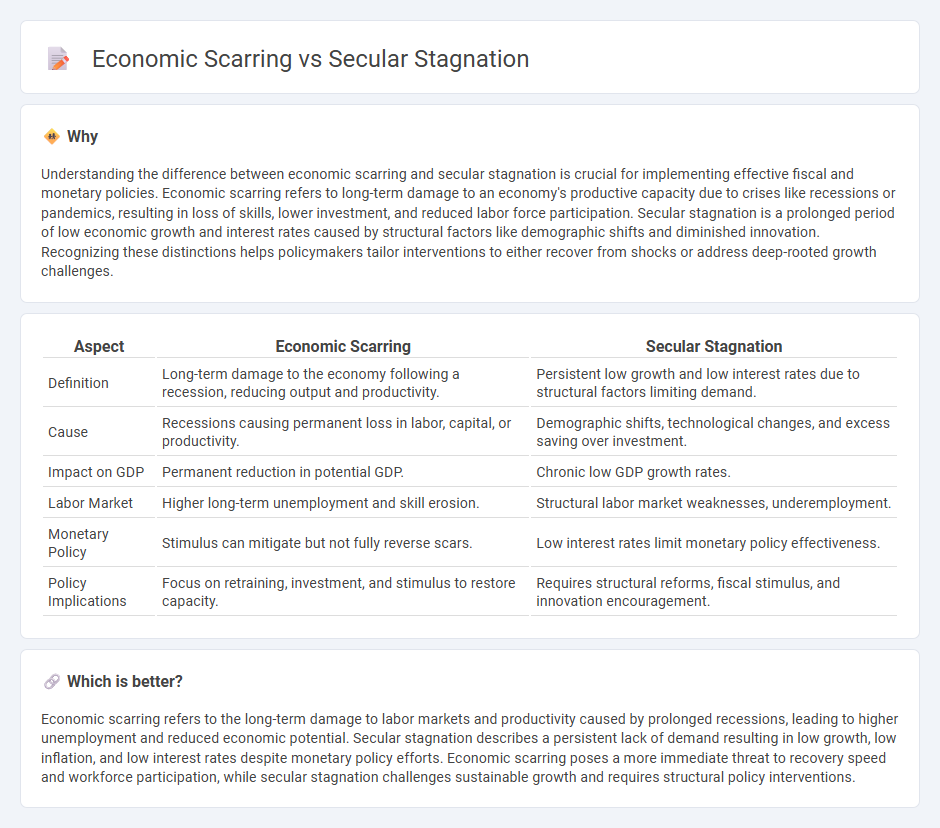
Economic scarring refers to the long-term damage to an economy caused by prolonged downturns, leading to reduced productivity, lower labor force participation, and persistent unemployment. Secular stagnation describes a persistent lack of demand growth, resulting in low interest rates and sluggish economic expansion despite monetary stimulus. Explore the differences and implications of these phenomena to understand their impact on future economic policies.
Why it is important
Understanding the difference between economic scarring and secular stagnation is crucial for implementing effective fiscal and monetary policies. Economic scarring refers to long-term damage to an economy's productive capacity due to crises like recessions or pandemics, resulting in loss of skills, lower investment, and reduced labor force participation. Secular stagnation is a prolonged period of low economic growth and interest rates caused by structural factors like demographic shifts and diminished innovation. Recognizing these distinctions helps policymakers tailor interventions to either recover from shocks or address deep-rooted growth challenges.
Comparison Table
| Aspect | Economic Scarring | Secular Stagnation |
|---|---|---|
| Definition | Long-term damage to the economy following a recession, reducing output and productivity. | Persistent low growth and low interest rates due to structural factors limiting demand. |
| Cause | Recessions causing permanent loss in labor, capital, or productivity. | Demographic shifts, technological changes, and excess saving over investment. |
| Impact on GDP | Permanent reduction in potential GDP. | Chronic low GDP growth rates. |
| Labor Market | Higher long-term unemployment and skill erosion. | Structural labor market weaknesses, underemployment. |
| Monetary Policy | Stimulus can mitigate but not fully reverse scars. | Low interest rates limit monetary policy effectiveness. |
| Policy Implications | Focus on retraining, investment, and stimulus to restore capacity. | Requires structural reforms, fiscal stimulus, and innovation encouragement. |
Which is better?
Economic scarring refers to the long-term damage to labor markets and productivity caused by prolonged recessions, leading to higher unemployment and reduced economic potential. Secular stagnation describes a persistent lack of demand resulting in low growth, low inflation, and low interest rates despite monetary policy efforts. Economic scarring poses a more immediate threat to recovery speed and workforce participation, while secular stagnation challenges sustainable growth and requires structural policy interventions.
Connection
Economic scarring refers to the long-term damage to an economy's productive capacity caused by prolonged recessions, such as high unemployment and reduced investment. Secular stagnation is characterized by persistently low growth and interest rates, often resulting from these scars that diminish aggregate demand and potential output. The interplay between economic scarring and secular stagnation creates a feedback loop, where damaged economic fundamentals suppress growth, reinforcing stagnation.
Key Terms
Aggregate Demand
Secular stagnation refers to a prolonged period of insufficient aggregate demand causing persistently low growth and inflation, while economic scarring results from deep, lasting damage to productive capacity following crises. Both phenomena highlight the critical role of aggregate demand in shaping economic recovery, with demand shortfalls leading to underutilization of resources and weak investment incentives. Explore how targeted fiscal and monetary policies can address these challenges to revitalize demand and promote sustainable growth.
Potential Output
Secular stagnation refers to a prolonged period of low economic growth due to insufficient demand, whereas economic scarring impacts potential output by permanently reducing labor force participation and productivity. Potential output measures the economy's maximum sustainable production capacity, which declines sharply under economic scarring but may stabilize during secular stagnation. Explore how these dynamics affect future growth forecasts and policy responses by learning more about potential output trends and their determinants.
Labor Market Dynamics
Secular stagnation refers to a prolonged period of negligible or no economic growth, often characterized by insufficient demand and low interest rates, which can depress labor market dynamics by limiting job creation and wage growth. Economic scarring involves long-term damage to the labor market following a recession or crisis, including increased structural unemployment and skills erosion, reducing workforce participation and productivity. Explore more about how these phenomena reshape labor market trends and policy responses.
Source and External Links
Will secular stagnation return? The stakes for current economic debates and fiscal policy - Secular stagnation refers to a chronic shortfall in aggregate demand relative to an economy's productive capacity, driven largely by structural factors such as rising income inequality that reduces household spending growth over decades.
Secular stagnation - Wikipedia - Secular stagnation is a long-term condition of negligible or no economic growth in market economies, originally described by Alvin Hansen in 1938 as a potential fate of the US economy after the Great Depression due to declining investment opportunities.
Secular Stagnation - Definition, Problems, Solutions - Economist Larry Summers characterizes secular stagnation as an imbalance from increased saving and reduced investment propensities, fueled by inequality, which depresses demand and growth; he advocates aggressive government spending to boost demand and counteract stagnation.
 dowidth.com
dowidth.com